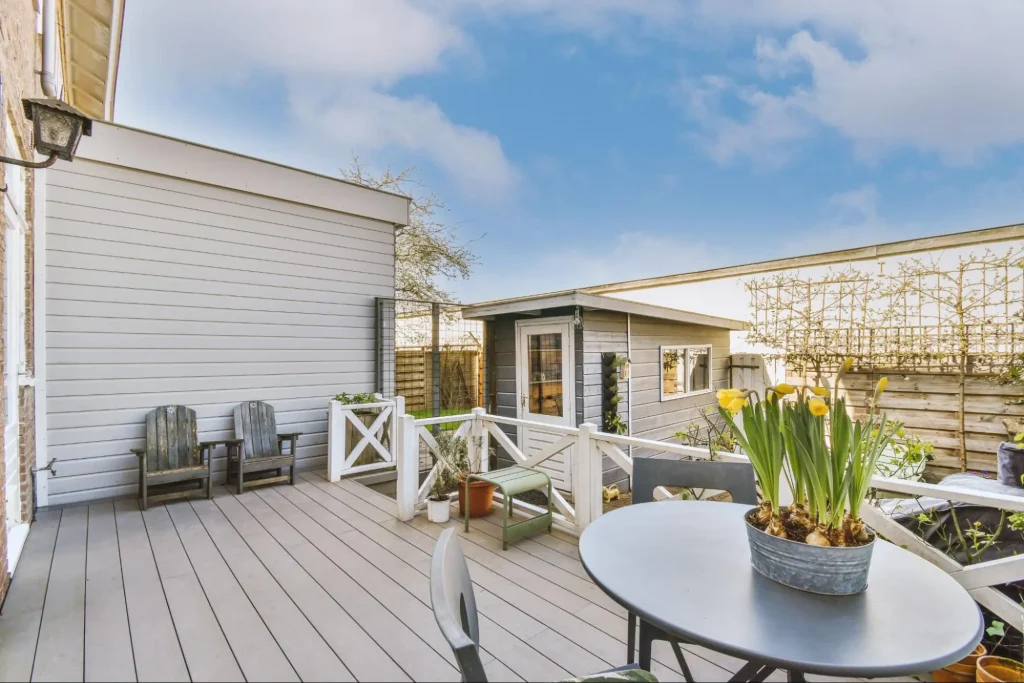
Keeping your deck in top shape doesn’t have to be a daunting task. With regular maintenance, you can ensure its longevity and preserve its value. The most important step you can take is to establish a routine for cleaning and inspecting your deck. Regularly sweeping away leaves, dirt, and debris can prevent damage and extend the life of your deck.
Look out for signs of damage like rot, decay, or loose boards. Address any issues promptly to avoid further deterioration. Protective measures, such as applying a sealant or using furniture pads, can also help safeguard your deck from wear and tear.
By implementing these simple maintenance steps, you’ll not only keep your deck looking great but also enhance its overall functionality. This attention to detail will make your outdoor space enjoyable for many years to come.
Keeping your deck in great shape involves regular cleaning and thorough inspections. This helps prevent damage and keeps the deck looking its best. This section covers sweeping and washing, inspecting for damage, and managing mildew and mold.
Sweeping is a simple yet essential part of deck maintenance. Leaves, dirt, and debris can accumulate quickly. Use a broom to sweep away anything that can trap moisture and lead to rotting or mildew.
For deeper cleaning, use a deck cleaner. You can opt for a garden hose or a pressure washer. A pressure washing session once a year can remove grime and algae. Be careful with the pressure setting to avoid damaging the wood.
Washing with water and a mild detergent can also work for regular upkeep. Scrub with a brush to remove stubborn stains. Ensuring thorough drying after washing helps protect against water damage.
Inspection is crucial for identifying any damage early. Check your deck at least once a year for signs of water damage, loose nails, and weakened boards. Look closely at the areas that are in contact with the ground as they are more prone to rot.
Pay special attention to the railing, steps, and areas that are frequently used. Loose or rotting parts should be repaired immediately to prevent accidents. Tighten any loose screws or replace rusted nails to keep the structure safe.
Regular inspections can help spot problems early, avoiding costly repairs in the future.
Mildew and mold can affect the appearance and safety of your deck. These often appear as dark spots on the surface. To remove them, use a mix of water and oxygen bleach, which is less harsh than chlorine bleach yet effective.
Apply the solution to the affected areas, scrub with a brush, and rinse thoroughly with water. Be sure the deck is completely dry before applying any sealant or finish.
To prevent mildew and mold from coming back, keep the deck clean and dry. Trim back plants and trees around your deck to improve sunlight and airflow, which can reduce the growth of mold and mildew.
Following these steps can help maintain a safe and attractive deck. Regular cleaning and careful inspections are key to long-lasting deck upkeep.

Damage to your deck can come from weather, pests, or simply wear and tear. To keep your deck safe and looking great, you need to fix structural issues, treat wood rot, handle pest infestations, and replace damaged nails or fasteners.
Check the framing, joists, beams, and footings for any signs of damage. Look for cracks, splintering, or warped wood.
If you notice damaged joists or beams, you will need to replace them. Use a pry bar to remove the damaged boards carefully. Replace them with boards of the same type and size. Secure the new boards using screws or nails.
If footings are unstable, you may need to dig around them and pour new concrete. Ensure the new footing is level and properly aligned with the existing structure. Regular inspections can help you spot issues early and prevent major repairs.
Wood rot and pests like termites can cause severe damage to wood decks. To check for rot, press a screwdriver into the wood. If it easily penetrates, the wood could rot.
Cut out the affected areas using a saw and replace them with pressure-treated lumber. Seal the new wood with a wood preservative to protect it from future rot.
For termite infestations, look for small holes or tunnels in the wood. Treat the area with a termite control product. In severe cases, you might need to replace the damaged boards entirely. Keeping your deck dry and well-sealed can prevent these issues.
Loose or rusted nails and screws can be hazardous. Check all nails, screws, and other fasteners regularly to ensure they are secure.
If nails are popping up, use a hammer to drive them back in. If they will not stay, replace them with screws, which provide a firmer hold. For rusted or corroded fasteners, remove them carefully and replace them with stainless steel or galvanized ones.
Make sure all fasteners are properly flush with the deck surface to prevent tripping hazards or further damage. Regular maintenance of nails and fasteners keeps your deck safe and looking neat.

Taking the right steps to protect your deck will significantly enhance its lifespan and maintain its integrity. Key areas to focus on include staining and sealing, using weatherproofing materials, and addressing wear and tear promptly.
Staining and sealing your deck protects it from moisture and UV rays, which can cause significant damage over time. To begin, choose a stain that matches your deck’s material—cedar, redwood, or composite. Staining enhances the wood’s natural beauty and provides a layer of protection against the elements.
After staining, apply a water-repellent sealant to lock in the stain and prevent water damage. Sealing is particularly important for wooden decks as it prevents water from seeping into the wood, causing rot and decay. A good practice is to reapply the stain and seal every two to three years or when water stops beading on the surface.
Using a power washer can help clean the deck thoroughly before applying stain and sealant. This ensures that dirt and debris do not interfere with the sealing process.
Weatherproofing materials are essential for protecting your deck from varying climate conditions. Consider using composite decking materials, which are designed to withstand harsh weather better than traditional wood. Composite decks are resistant to rotting, splitting, and warping, making them a great option for long-term durability.
For wood decks, apply a wood preservative to protect against insect damage and UV radiation. Products like water-repellent sealants also offer added protection against rain and snow, reducing the risk of water damage.
Use plastic sheeting or tarps to cover areas of the house close to the deck when applying any chemicals. This prevents accidental splashes or drips from damaging other parts of your home.
Regularly inspect your deck for signs of wear and tear to address issues before they worsen. Look for loose nails, cracked boards, and signs of rot. Tighten any loose parts and replace damaged boards promptly to maintain the structural integrity of your deck.
Handrails and stairs are high-traffic areas that often need extra attention. Reinforce these areas with additional support if needed. For composite decks, check for fading or scratches and use repair kits that match the material.
Cleaning your deck with a biodegradable wood deck cleaner helps maintain its appearance and prevent further damage. Make this part of your regular maintenance routine to keep your deck in top shape.
Elevate the look and usability of your deck by paying attention to maintenance and improvements. Focus on furniture upkeep and enhancing safety and accessibility to create a welcoming and secure outdoor space.
Your outdoor furniture can significantly enhance the aesthetic appeal of your deck. Regular maintenance of your furniture and accessories not only boosts their longevity but also keeps them looking their best. Clean your furniture pieces like tables and chairs regularly to prevent dirt and grime buildup. Use a mild deck cleaner suitable for wooden decks.
Check for rust on metal parts and repaint or seal them as needed. Wooden furniture requires sanding and restaining to protect against the sun’s harmful rays.Planters and other accessories should also be cleaned and inspected for damage. Replace any broken or worn items promptly to maintain a polished look.
Safety and accessibility are key when maintaining your deck. Ensure that handrails and railings are securely fastened and free from splinters or sharp edges. Regularly inspect and repair stairs to prevent accidents.
Install non-slip mats or strips on stair treads to provide extra traction, especially in wet conditions. Adequate lighting is crucial for evening use. Place solar-powered lights along the steps and railings for better visibility.
Consider adding ramps to improve accessibility for everyone, including those with mobility issues. Regularly check for any structural damage or weak spots to prevent potential hazards.
Consistent maintenance and thoughtful enhancements will help you create a more enjoyable and safe outdoor environment.
Regular maintenance is key to keeping your deck in great shape. First, you should clean your deck regularly. This helps remove mold, algae, and grime that can make the surface look unattractive. For a deeper clean, consider using a power washer once a year.
It’s also important to protect your deck from scrapes. Avoid using outdoor rugs made from natural fibers. Instead, opt for synthetic materials that won’t trap moisture. Scratches from furniture can be minimized by using furniture pads.
Use a clear sealer to protect your deck from moisture and UV damage. This simple step can extend the life of your deck significantly. Make sure to reapply the sealer as per the manufacturer’s recommendations, usually every couple of years.
Keep an eye out for damage. Regularly check for loose boards, nails, or screws, and fix them immediately. This prevents minor issues from becoming major repairs.
For more detailed maintenance, contact Kaminskiy Care and Repair for all your home maintenance needs.
Maintaining your deck doesn’t have to be complicated. With regular cleaning, protection, and timely repairs, your deck will remain a safe and beautiful part of your home for years to come.
Regular cleaning is crucial. Sweep leaves, dirt, and debris off your deck often. Deep clean annually using a power washer to remove grime. Apply the best wood treatment, like an oil-based stain, to protect against mold and cracking. Inspect for loose nails or boards and fix them promptly.
Using oil-based stains is highly recommended. They enhance natural wood color and prevent mold and mildew growth. Oil-based stains also help prevent cracking and warping. Avoid water-based stains because they may wear more quickly and not last as long.
Regular cleaning should be done weekly or bi-weekly. Deep cleaning and re-staining or sealing should be done annually to ensure maximum protection and longevity of your deck.
Keep it clean by sweeping and washing it regularly. Inspect the paint for chips or cracks and touch up any damaged areas promptly. Repaint every few years to maintain its look and protection.
Regular maintenance is key. Clean it frequently, use quality stains or treatments annually, and address repairs quickly. Protect your deck from the elements by using a cover when not in use and avoid dragging heavy furniture across it.